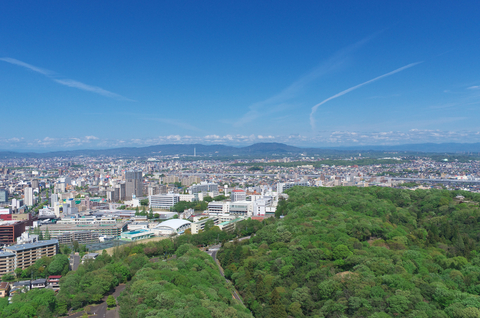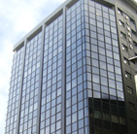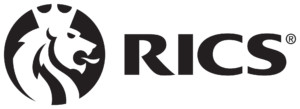
[Updated Oct 2020] A guide to serviced offices and office space to rent in Nagoya as well as general information that may be useful if you are considering renting office space in the city.
For further Nagoya office space information or to search office space for rent in Nagoya just click. Or contact us for any office space query.
History & Geography
Nagoya is the third-largest city in Japan and one of the major ports of the country. Located on the main island of Honshu, on the Pacific coast, the city’s location at the centre of the country has played a large role in its importance as a strategic and commercial centre. Nagoya lies on the north of Ise Bay on the Nobi Plain on low lying plateaus. To the west of the city flows the Kiso River and to the northeast Shonai River. Nagoya was the home of the Toyotomi Hideyoshi and Tokugawa Ieyasu, the two most powerful warlords in Japanese history. The town of Nagoya came into being when the Nagoya Castle was built in the early 17th century. At the same time, the castle was built so was the nearby Atsuta Shrine, which also caused people to move to the area to live. Another factor contributing to the importance of Nagoya was the fact that it lay directly on the road connecting the ancient capitals of Kyoto and Edo (Tokyo). Nagoya soon grew into an important industrial centre, with much of the activity centred around the pottery industry. It was also one of the main production centres of gunpowder. In 1889 under the Meiji Restoration, Nagoya was proclaimed an official city. During WWII Nagoya was a target of allied bombing raids because it was a major centre of the Japanese aircraft industry and also manufactured machine parts. The city was bombed throughout the war and suffered heavy damage. Almost one-fourth of the city was completely destroyed. Following the war, the city was extensively rebuilt and soon prospered once more. Throughout the 1980s the city diversified its economy into IT and various other manufacturing areas. Today Nagoya is the capital of the Aichi Prefecture and one of the most economically and culturally important cities in Japan.
Economy
The main industry in Nagoya is auto manufacturing. Some have described the city as the Japanese equivalent of Detroit. Among the auto companies based in Nagoya are Lexus, Toyota’s luxury brand and the R&D division of Mitsubishi. There are also many auto suppliers located in the city, such as JTEKT, Aisin Seiki and DENSO. The ceramics industry is also still a substantial bulwark of the economy. The largest ceramic outfit headquartered in Nagoya is Noritake. Aerospace also has a large presence in Nagoya. Boeing, Pratt & Whitney, Mitsubishi Heavy Industries, Bodycote, Kawasaki Heavy Industries and Fuji Heavy Industries are all located in the city. Yet another major area of the economy in Nagoya is robotics. There are several large robotics companies located in Nagoya and mechanized puppets dubbed ‘karakuri ningyo’ are very popular in the city. Other large companies which call Nagoya home are the confectionary giant Marukawa and Nippon Sharyo which makes the famous Japanese bullet trains. Greater Nagoya consistently earns approximately 70 percent of Japan’s trade surplus every year. Nagoya has a population of over two million with only Tokyo and Osaka having larger populations.
Tourism & Culture
Nagoya has a thriving tourism industry and every year sees thousands of visitors. The city is full of ancient shrines, temples and castles which are popular with tourists. Many walk the ‘Cultural Path’, a trail leading from Tokugawa Art Museum to Nagoya Castle. The trail winds its way through an old residential district with many scenic houses and buildings. Among the oldest buildings in the city are the Nagoya City Hall, Nagoya Archives and the Aichi Prefectural Office. Nagoya Castle also functions as a museum and is a must-see for tourists. Nagoya also has a number of festivals which bring flocks of visitors every year. The most popular of these are the Atsuta Festival which takes place at the Atsuta Shrine every June, the Port Festival, the Nagoya Festival and the Nagoya Castle Summer Festival. The city also boasts a host of museums. The largest of these is the Tokugawa Art Museum, the Nagoya City Museum, the Noritake Garden and the Toyota Automobile Museum. Most visitors to Nagoya also sample the local cuisine, some specialities of which include chicken wings marinated in sweet sauce, flat udon noodles and uiro rice dumplings. Of course, Nagoya also has its own distinctive brands of Sake rice wine to go with its food.
Transportation
The city of Nagoya is served by Chubu Centrair International Airport which is on an artificial island in the bay. The name ‘centrair’ is short for Central Japan International Airport. Over 11 million people use the airport every year and it is the 8th busiest in the nation. Regional rail service is provided by Nagoya Station. The Nagoya Subway serves the city’s public transportation needs, along with a comprehensive bus system. Nagoya’s subway has 47 lines and almost three million people per day use it.

Office space to rent in Nagoya
Nagoya currently has a vacancy rate of approximately 12 percent, much higher than usual in the city. This is the result of several factors. There is a major oversupply in the city due to a glut of projects reaching readiness at the same time over the last few years. Demand has also been decreasing steadily and there are fears of the vacancy rate climbing even higher over the next term. Most of the office space in the city is located in the Yodoyabashi, Umeda and Honmachi neighbourhoods, though there are also several large office parks on the outskirts of the city.
Our office space search, advisory and acquisition services are FREE, always. Our Nagoya office space brokers and agents are globally regulated by the Royal Institution of Chartered Surveyors (RICS) ensuring the highest standards of commercial property advice and service at all times.
